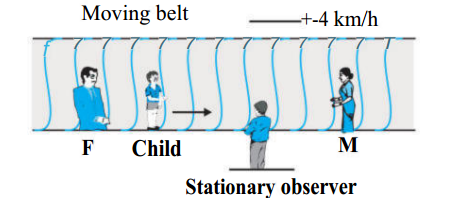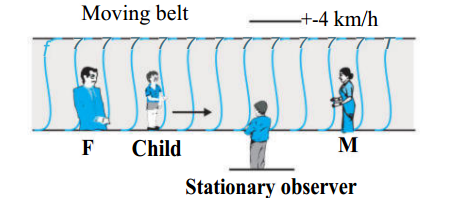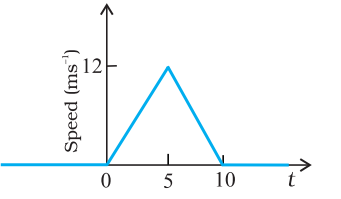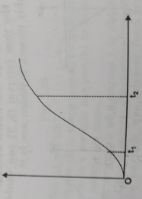Complete Solutions to EXAMPLE of chapter MOTION IN A STRAIGHT LINE of Class 11 book with complete answers and questions
| Class 11 | PHYSICS |
| Chapter | MOTION IN A STRAIGHT LINE |
| MBD | EXAMPLE |
| Number Of Questions | 100 |
| Academic Year | 2023-24 |
State in each case, whether the motion is one, two or three dimensional. An ant crawling on globe
01:34View SolutionState in each case, whether the motion is one, two or three dimensional. A piece of paper flying in the sky.
01:44View SolutionState in each case, whether the motion is one, two or three dimensional. A speeding bus on a straight highway Moon revolving around the earth.
01:50View SolutionIs it possible that displacement is zero, but not the distance? Give example.
02:03View SolutionCan earth be regarded as a point object when it is describing its yearly journey around the sun?
01:30View SolutionCan a body have a constant velocity but varying speed?
01:20View SolutionCan a body have a constant speed but a varying velocity?
01:21View SolutionWhat will be the nature of x - t graph for a uniform motion?
01:42View SolutionCan x - t graph be a striaght line parallel to position axis?
01:46View SolutionDefine kinematics.
01:41View SolutionCan the speed of a body be negative?
01:21View SolutionWhat can you say about the motion of object whose distance - time graph is a straight line parallel to time axis ?
01:59View SolutionWhat does the slope of position-time graph represents?
01:36View SolutionUnder what condition is the average velocity equal to instantaneous velocity?
01:43View SolutionWhat is the numerical ratio of velocity to speed of an object?
01:57View SolutionShow that rest and motion are relative terms.
03:19View SolutionWhat do you understand by positive and negative time?
01:25View SolutionWhat does slope of (v-t) graph represent?
01:25View SolutionA ball is thrown straight up. What is its velocity ad acceleration at the highest point?
01:38View SolutionWhy does time occur twice in a unit of acceleration?
01:14View SolutionCan a body have zero velocity and still be accelerated?
02:03View SolutionWhat is the acceleration of a particle moving with a uniform velocity?
01:23View SolutionWhat is the nature of acceleration-time graph when the body moves with constant acceleration ?
01:47View SolutionIf the instantaneous velocity of a particle is zero will its instantaneous acceleration be necessarily zero?
01:54View SolutionCan the velocity of an object be in a direction other than the direction of acceleration?
01:31View SolutionTwo balls of different masses (one lighter and other heavier) are thrown vertically upward with same initial speed. Which one will rise to the greater height)?
01:44View SolutionWhich of the two velcotiy and acceleration, gives the direction of motion of the body? Explain.
01:49View SolutionIn which of the following examples of motion, can the body be considered approximately a point object:
07:45View SolutionA woman starts from her home at 9.00 am, walks with a speed of `5 km h^-1` on a straight road up to her office 2.5 km away, stays at the office up to 5.00 pm, and returns home by an auto with a speed of `25 km h^-1`.Choose suitable scales and plot the x-t graph of her motion.
04:11View SolutionA drunkard walking in a narrow lane takes 5 steps forward and 3 steps backward, followed again by 5 steps forward and 3 steps backward, and so on. Each step is 1 in long and requires 1 s. Plot the x-t graph of his motion. Determine graphically and otherwise how long the drunkard takes to fall in a pit 13 m away from the start.
04:40View SolutionA jet airplane travelling at the speed of `500 km h^-1`' ejects its products of combustion at the speed of `1500 km h^-1`' relative to the jet plane. What is the speed of the latter with respect to an observer on the ground ?
04:01View SolutionA car moving along a straight highway with speed of `126 km h^-1' is brought to a stop within a distance of 200 m. What is the retardation of the car (assumed uniform), and how long does it take for the car to stop ?
03:20View SolutionTwo trains A and B of length 400 m each are moving on two parallel tracks with a uniform speed of `72 km h^-1` in the same direction, with A ahead of B. The driver of B decides to overtake A and accelerates by `1 m s^-2`. If after 50 s, the guard of B just brushes past the driver of A, what was the original distance between them ?
04:51View SolutionOn a two-lane road, car A is travelling with a speed of `36 km h^-1` . Two cars B and C approach car A in opposite directions with a speed of `54 km h^-1` each. At a certain instant, when the distance AB is equal to AC, both being 1 km, B decides to overtake A before C does. What minimum acceleration of car B is required to avoid an accident ?
06:17View SolutionTwo towns A and B are connected by a regular bus service with a bus leaving in either direction every T minutes. A man cycling with a speed of `20 km h^-1` in the direction A to B notices that a bus goes past him every 18 min in the direction of his motion, and every 6 min in the opposite direction. What is the period Tof the bus service and with what speed (assumed constant) do the buses ply on the road?
05:25View SolutionA player throws a ball upwards with an initial speed of `29.4 m s^-1` :- What is the direction of acceleration during the upward motion of the ball ?
01:31View SolutionA player throws a ball upwards with an initial speed of `29.4 m s^-1` :- What are the velocity and acceleration of the ball at the highest point of its motion ?
02:27View SolutionA player throws a ball upwards with an initial speed of `29.4 m s^-1` :- What are the velocity and acceleration of the ball at the highest point of its motion ?
02:27View SolutionA boy standing on a stationary lift (open from above) throws a ball upwards with the maximum initial speed he can, equal to `49 m s^-1` . How much time does the ball take to return to his hands? If the lift starts moving up with a uniform speed of `5 m s^-1` and the boy again throws the ball up with the maximum speed he can, how long does the ball take to return to his hands ?
05:39View SolutionRead each statement below carefully and state with reasons and examples, if it is true or false :- A particle In one-dimensional motion:- with zero speed at an instant may have non-zero acceleration at that instant
03:19View SolutionRead each statement below carefully and state with reasons and examples, if it is true or false :- A particle In one-dimensional motion:- with zero speed may have non-zero velocity,
02:51View SolutionRead each statement below carefully and state with reasons and examples, if it is true or false :- A particle In one-dimensional motion:- with constant speed must have zero acceleration,
02:32View SolutionRead each statement below carefully and state with reasons and examples, if ti is true or false: A particle in one dimensional motion.
with positive value of acceleration must be speeding up.04:33View SolutionA ball is dropped from a height of 90 m on a floor. At each collision with the floor, the ball loses one tenth of its speed. Plot the speed-time graph of its motion between t = 0 to 12 s.
08:11View SolutionExplain clearly, with examples, the distinction between :- magnitude of displacement (sometimes called distance) over an interval of time, and the total length of path covered by a particle over the same interval,
04:41View SolutionExplain clearly, with examples, the distinction between :- magnitude of average velocity over an interval of time, and the average speed over the same interval. [Average speed of a particle over an interval of time is defined as the total path length divided by the time interval]. Show in both (a) and (b) that the second quantity is either greater than or equal to the first. When is the equality sign true ? [For simplicity, consider one-dimensional motion only].
03:47View SolutionA man walks on a straight road from his home to a market 2.5 km away with a speed of `5 km h^-1` . Finding the market closed, he instantly turns and walks back home with a speed of `7.5 km h^-1`. What is the :- magnitude of average velocity, and
03:35View SolutionA man walks on a straight road from his home to a market 2.5 km away with a speed of `5 km h^-1` . Finding the market closed, he instantly turns and walks back home with a speed of `7.5 km h^-1`. What is the :- magnitude of average velocity, and
03:35View SolutionIn Exercises 3.13 and 3.14, we have carefully distinguished between average speed and magnitude of average velocity. No such distinction is necessary when we consider instantaneous speed and magnitude of velocity. The instantaneous speed is always equal to the magnitude of instantaneous velocity. Why ?
03:37View SolutionLook at the graphs (Fig. 3.20) carefully and state, with reasons, which of these cannot possibly represent one-dimensional motion of a particle.
 02:43View Solution
02:43View SolutionFigure 3.21 shows the x-t plot of one-dimensional 4 motion of a particle. Is it correct to say from the graph that the particle moves in a straight line for t< 0 and on a parabolic path for t >0 ? If not, suggest a suitable physical context for this graph.
 02:43View Solution
02:43View SolutionA police car running on a highway with a speed of `30 km//h` fires on the vehicle of thiefs running in the same direction at a speed of` 192 km//h`. If the velocity of the bullet is `150 m//s`then with what velocity the bullet will hit the thiefs ?
05:53View SolutionSuggest a suitable physical situation for each of the following graphs:
 06:06View Solution
06:06View SolutionIn the figure gives the (x-t) plot of a particle executign one-dimensional simple harmonic motion. Give the signs of position, velocity and acceleration variables of the particle at t = 0.3 s, 1.2 s, - 1.2 s.
 03:06View Solution
03:06View SolutionFigure 3.24 gives the x-t plot of a particle in one-dimensional motion. Three different equal intervals of time are shown. In which interval is the average speed greatest, and in which is it the least ? Give the sign of average velocity for each interval.
 02:42View Solution
02:42View SolutionIn the figure gives a speed-time graph of a particle in motion along a constant direction. Three equal intervals of time are shwon. In which interval is the average acceleration greatest in magnitude ? In which interval is the average speed greatest ? Choosing the positive direction as the constant direction of motion, give the signs of v and a in the three intervals. What are the acceleration at the points A,B,C and D?
 04:38View Solution
04:38View SolutionA three-wheeler starts from rest, accelerates uniformly with `1 m s^-2` on a straight road for 10 s, and then moves with uniform velocity. Plot the distance covered by the vehicle during the 11th second (n = 1,2,3....) versus 11. What do you expect this plot to be during accelerated motion : a straight line or a parabola ?
03:41View SolutionA boy standing on a stationary lift (open from above) throws a ball upwards with the maximum initial speed he can, equal to `49 m s^-1` . How much time does the ball take to return to his hands? If the lift starts moving up with a uniform speed of `5 m s^-1` and the boy again throws the ball up with the maximum speed he can, how long does the ball take to return to his hands ?
05:39View SolutionOn a long horizontally moving belt (Fig. 3.26), a child runs to and fro with a speed `9 km h^-1` (with respect to the belt) between his father and mother located 50 m apart on the moving belt. The belt moves with a speed of `4 km h^-1`. For an observer on a stationary platform outside, what is the:- speed of the child running in the direction of motion of the belt ?.
 02:53View Solution
02:53View SolutionOn a long horizontally moving belt (Fig. 3.26), a child runs to and fro with a speed `9 km h^-1` (with respect to the belt) between his father and mother located 50 m apart on the moving belt. The belt moves with a speed of `4 km h^-1`. For an observer on a stationary platform outside, what is the:- speed of the child running opposite to the direction of motion of the belt ?
 02:55View Solution
02:55View SolutionOn a long horizontally moving belt (Fig. 3.26), a child runs to and fro with a speed `9 km h^-1` (with respect to the belt) between his father and mother located 50 m apart on the moving belt. The belt moves with a speed of `4 km h^-1`. For an observer on a stationary platform outside, what is the:- time taken by the child in (a) and (b) ? Which of the answers alter if motion is viewed by one of the parents ?
 02:33View Solution
02:33View SolutionTwo stones are thrown up simultaneously from the edge of a cliff 200 m high with initial speeds of `15 m s^-1` and 30 m s^-1`. Verify that the graph shown in Fig. 3.27 correctly represents the time variation of the relative position of the second stone with respect to the first. Neglect air resistance and assume that the stones do not rebound after hitting the ground. Take g = `10 m s^-2`. Give the equations for the linear and curved parts of the plot.
 01:37View Solution
01:37View SolutionThe speed-time graph of a particle moving along a fixed direction is shown in Fig. 3.28. Obtain the distance traversed by the particle between:-t = 0 s to 10 s,
 01:37View Solution
01:37View SolutionThe velocity-time graph of particle in one dimensional motion is shown in the fig.

Which if the following formulae are correct for describing the motion of the pawrticle over the time interval `t_1 to t_2`
`v(t_2) = v(t_1) + a(t_2 - t_2)`, `v_(average) = ([x(t_2) - x(t_1)])/((t_2 - t_1))`, ` x(t_2) - x(t_1) `= area under the v - t curve. bounded by the t-axis and the dotted line shown.03:50View SolutionA lift is coming form 8th floor and is just about to reach 4th floor. Taking ground floor as origin and positive direction upwards for all quantities, which one of the folowing is correct?
01:59View SolutionIn one dimensional motion, instaneous speed v satisfies `0 lev < v_0`
02:40View SolutionA vehicle travels half the distance L with speed `V_1` and the other half with dspeed `v_2`, then its average speed is
02:21View SolutionThe displacement of a particle is given by ` x = (t-2)^2` where x is in metres and t in seconds. The distance covered by the particle in first 4 seconds is
01:51View SolutionAt a metro station, a girl walks up a stationary esclator in time `t_1`. If she remains stationary on the escalator, then the escalator take her up in time `t_2`. The time taken by her to walk up on the moving escalator will be
02:48View SolutionThe variation of quantity A with quantity B, plotted in fig. describes the motion of a particle in a straight line.
 02:59View Solution
02:59View SolutionA graph of x versus t is shown in fig. choose corredt alternatives from below.
 03:50View Solution
03:50View SolutionA particle executes the motion described by `x(t) = x_0 (1-e^(-gammat) , t le 0, x_0 > 0`. Where does the particle start and with what velocity?
01:55View SolutionA spring with one end attached to a mass and the other to a rigid suppord is stretched and released.
04:01View SolutionA ball is bouncing elastically with a speed 1 m/s between walls of a railways compartment of size 10 m in a direction perpendicular to wals. The train is moving at a constant velocity of 10 m/s parallel to the direction of motion of the ball . As seen from the ground
06:08View SolutionRefer to the graph in fig match the following graph characteristic.
 04:52View Solution
04:52View SolutionA uniformly moving cricket ball is turned back by hitting it with a bat for a very short time interval. Show the variation of its acceleration with time. (Take acceleration in the bakward direction as positive).
02:07View SolutionGive examples of a one-dimensional motion where the particle moving along positive x-direction comes to rest periodically and moves forward.
01:40View SolutionGive examples of a one-dimensional motion where the particle moving along positive x-direction comes to rest periodically and moves backward.
01:12View SolutionGive example of a motion wehre x > 0. v < 0, a > 0 at a particular instant.
02:23View SolutionAn object falling through a fluid is observed to have acceleration given by a = g - bv where g = gravitational acceleration and b is constant. After a long time of release, it is observed to fall with constant speed.What must be the value of constant speed?
01:55View SolutionA particle executes the motion described by `x(t) = x_0 (1-e^(-gammat) , t le 0, x_0 > 0`. Where does the particle start and with what velocity?
01:55View SolutionA particle executes the motion described by `x(t) = x_0 (1-e^(-gammat) , t le 0, x_0 > 0`. Find maximum and minimum vlaues of x(t), v(t), a (t). Show that x (t) and a (t) increase with time and v (t) decreases with time.
04:29View SolutionA bird is tossing (flying to and fro 0 between two cars moving towards each other on a straight road. On car has a speed of 18 km /h while the other has the speed of 27 km /h. The bird starts moving from first caer towards the other and is moving with the speed of 36 km /h and when the two cars were separated by 36 km. What is the total distance comered by the bird ? What is the total displacement of the bird ?
03:53View SolutionA man runs across the roof-top of a tall building and jumps horizontally with the hope of landing on the roof of the next building which is of a lower height than the first. If his speed is 9 m/s, the distance between the two buildings is 10 m and the height difference is 9 m, will he be able to land on the next building?
02:32View SolutionIt is a common observation that rain clouds can be at about a kilometer altitude above the ground.
If a rain drop falls from such a height freely under gravity, what will be its speed? Also calculate in km/h. `(G = 10 m//s^2)`.01:55View SolutionIt is a common observation that rain clouds can be at about a kilometer altitude above the ground.
A typical rain drop is about 4 mm diameter. Momentum is mass `xx` speed in magnitude. Estimate its momentum when it hits the ground.02:38View SolutionIt is a common observation that rain clouds can be at about a kilometer altitude above the ground.
If the diameter of the rain drop is 4mm then Estimate the time required to flatten the drop.01:47View SolutionIt is a common observation that rain clouds can be at about a kilometer altitude above the ground.
Rate of change of momentum is force. Estimate how much force such a drop would exert on you.
(`g = 10 m / s^2` and diameter of drop = 4mm)06:37View SolutionIt is a common observation that rain clouds can be at about a kilometer altitude above the ground.
Estimate the order of magnitude force on umbrella. Typical lateral separation between two rain drops is 5 cm.
(`g = 10 m / s^2` and diameter of drop = 4mm)09:52View SolutionA motor car moving at a speed of 72 km /h can not come to a stop in less than 3.0 s while for a truch this time interval is 5.0s On a highway the car is behind the truck both moving at 72 km /h The truck geives a signal that it is going to stop at emergency. At what distance the car should be from the truck so that it does bot bump onto (collide with) the truck. Human responde time id 0.5 s. (comment : This is to illustrate why vehicles carr the message on the rear side. "Keep safe Distance").
14:43View SolutionA monkey climbs up a slippery pole for 3 seconds and susequently slips for 3 seconds. Its velocity at time t is given by v (t) = 2t (3-t) , 0 < t < 3 and v (t) = - t-3) (6-t) for 3 < t < 6 s I m/s. It repeats this cycle till it reaches the height of 20 m.
At what time is its velocity maximum?02:42View SolutionA monkey climbs up a slippery pole for 3 seconds and susequently slips for 3 seconds. Its velocity at time t is given by v (t) = 2t (3-t) , 0 < t < 3 and v (t) = - t-3) (6-t) for 3 < t < 6 s I m/s. It repeats this cycle till it reaches the height of 20 m.
At what time is its average velocity maximum?03:14View SolutionA monkey climbs up a slippery pole for 3 seconds and susequently slips for 3 seconds. Its velocity at time t is given by v (t) = 2t (3-t) , 0 < t < 3 and v (t) = - t-3) (6-t) for 3 < t < 6 s I m/s. It repeats this cycle till it reaches the height of 20 m.
At what time is its average velocity maximum?03:14View SolutionA monkey climbs up a slippery pole for 3 seconds and susequently slips for 3 seconds. Its velocity at time t is given by v (t) = 2t (3-t) , 0 < t < 3 and v (t) = - t-3) (6-t) for 3 < t < 6 s I m/s. It repeats this cycle till it reaches the height of 20 m.
How many cycles (counting fractions) are required to reach the top?03:46View SolutionA man is standing on top of a building 100 m high. He throws two balls vertically, one at t = 0 and other after a time interval (less than 2 s). The later ball is thrown at a velocity of half the first. The vertical gap between first and second ball is 15 m at t = 2 s. The gap is found to remain constant. The velocities with which the balls were thrown.
03:27View SolutionChoose the correct statement from the followoing:
02:54View SolutionThe study of motion, without consideration of its cause is stuidied in
01:32View SolutionThe ratio of the numerical values of the average velocity and average speed of a body is always:
01:55View SolutionIn 1.0 s, a particle goes form point A to point B, moving in a semicircle of radius 1.0 m. The magntiude of average ve3lcity is :
 01:29View Solution
01:29View SolutionWhich one of the following graphs represents motoin with unifrom speed?
02:05View Solution
EXAMPLE questions and complete solutions for chapter MOTION IN A STRAIGHT LINE of MBD of Class 11
